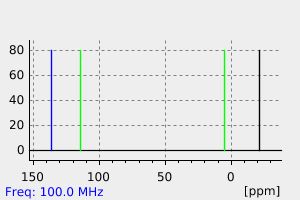3-(甲基碲基)-1-丙烯 | 114438-52-7
分子结构分类
中文名称
3-(甲基碲基)-1-丙烯
中文别名
——
英文名称
methyl(allyl)telluride
英文别名
3-methyltellanyl-1-propene;allylmethyltellurium;allylmethyltelluride;Methylallyltelluride;3-methyltellanylprop-1-ene
CAS
114438-52-7
化学式
C4H8Te
mdl
——
分子量
183.708
InChiKey
BDYWBKZPUOSJSR-UHFFFAOYSA-N
BEILSTEIN
——
EINECS
——
-
物化性质
-
计算性质
-
ADMET
-
安全信息
-
SDS
-
制备方法与用途
-
上下游信息
-
文献信息
-
表征谱图
-
同类化合物
-
相关功能分类
-
相关结构分类
计算性质
-
辛醇/水分配系数(LogP):1.34
-
重原子数:5
-
可旋转键数:2
-
环数:0.0
-
sp3杂化的碳原子比例:0.5
-
拓扑面积:0
-
氢给体数:0
-
氢受体数:0
反应信息
-
作为反应物:描述:参考文献:名称:使用甲基烯丙基碲化物低温生长 HgTe 和 HgCdTe摘要:使用甲基烯丙基碲化物 (MATe)、二甲基镉 (DMCd) 和元素汞,通过有机金属气相外延在低温下生长 HgTe 和 HgCdTe (MCT) 层。使用 MATe 可以在 250-320°C 的温度范围内生长层,这比使用二异丙基碲化物作为烷基碲时的生长温度低 50°C,且生长速率相同。通过光学显微镜、双晶 X 射线衍射和傅里叶变换红外光谱对这些层进行表征。在 320 °C 下的生长导致 HgTe 和 HgCdTe 层的无特征表面。X 射线衍射的半峰全宽(29 弧秒)非常窄,这证明了在 320°C 下生长的 HgTe 层的高质量,这与本研究中使用的 CdTeZn 衬底相当。DOI:10.1063/1.102124
-
作为产物:参考文献:名称:RADICAL POLYMERIZATION INITIATOR AND METHOD FOR PRODUCING POLYMERS摘要:本发明涉及一种自由基聚合引发剂,其包括由式(1)代表的有机碲化合物,其中R1代表烷基基团或类似物,R2和R3各自独立地代表氢原子或类似物,R4、R5和R6各自独立地代表氢原子或类似物。本发明提供了一种有用于生产在分子末端包含双键的聚合物的自由基聚合引发剂,以及利用该自由基聚合引发剂生产聚合物的方法。公开号:US20160297755A1
文献信息
-
Reaction of 1-bromo-3-chloropropane with tellur and dimethyltelluride in the system of hydrazine hydrate-alkali作者:N. V. Russavskaya、E. P. Levanova、E. N. Sukhomazova、V. A. Grabelnykh、A. V. Elaev、L. V. Klyba、E. R. Zhanchipova、A. I. Albanov、I. M. Korotaeva、D. S. Totyashinova、N. A. KorchevinDOI:10.1134/s1070363206050112日期:2006.5A synthesis of oligomeric substance of thiocol type, the poly(trimethyleneditelluride), from 1-bromo-3-chloropropane and elemental tellurium is performed using a hydrazine hydrate-alkali system. Reductive splitting of the tellurocol followed by alkylation with methyl iodide give rise to preparation of bis(methyltelluro)propane, which was synthesized also from dimethyltelluride and 1,3-dihalopropanes using the (N2H4H2O)-H-./KOH system. Mass spectra of the synthesized low molecular weight organotellurium compounds are considered.
表征谱图
-
氢谱1HNMR
-
质谱MS
-
碳谱13CNMR
-
红外IR
-
拉曼Raman
-
峰位数据
-
峰位匹配
-
表征信息
同类化合物
高氯酸钪
高氯酸胍
高氯酸甲酯
高氯酸四甲基铵
高氯酸四乙基铵
高氯酸吡咯烷
高氯酸三丁基锡
高氯酸[4-(2,5-二羰基吡咯烷-1-基)丁-2-炔-1-基](二甲基)锍
高氯酸2-羟乙基酯
高氯酸2-羟丙基酯
顺式-2-硝基环己基高氯酸盐
铵钪硝酸盐(2:1:5)
铵氧代-三氧代锝
铅(2+)砷酸盐-三丁基锡烷基水合物(3:2:2:1)
钪三溴酸盐
钠O-(四氢-2-呋喃基甲基)硫代硫酸酯
重铬酸咪唑
重铬酸吡啶
过氧硝酸甲酯
过氧硝酸环戊酯
过氧化,硝基1-羰基-2-丙烯基
过氧化,甲磺酰硝基
过氧丙酰硝酸酯
膦酸二异丁基酯
磷酸组胺
磷酸(羟基-甲氧基-磷酰)二甲酯
磷酸(羟基-异戊氧基磷酰)二异戊基酯
碳化钨
碲烷
碲杂环丁烷
碲吩-2-羧酸
碲吩
硼酸异辛酯
硼酸十六烷基酯
硼酸三辛酯
硼酸三甲酯
硼酸三烯丙酯
硼酸三正己酯
硼酸三月桂酯
硼酸三异丙酯
硼酸三庚酯
硼酸三亚甲酯
硼酸三乙酯
硼酸三丙酯
硼酸三丁酯-11B
硼酸三丁酯-10B
硼酸三丁酯
硼酸三-[3-(3-甲氧基-丙氧基)-丙基]酯
硼酸三-(2-氯甲氧基-乙基)酯
硼酸三(六氟异丙基)酯







